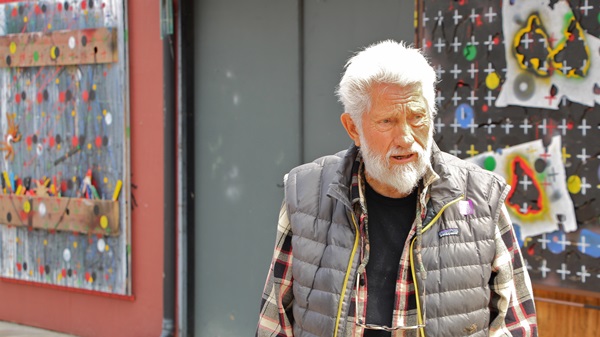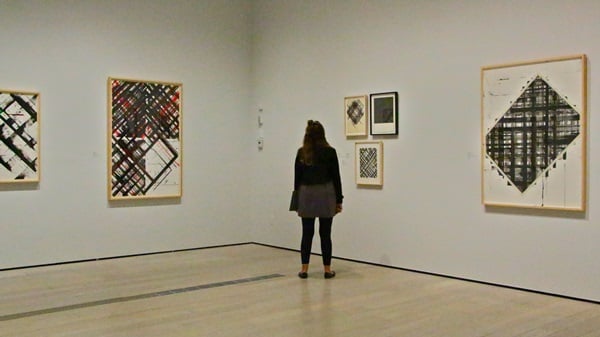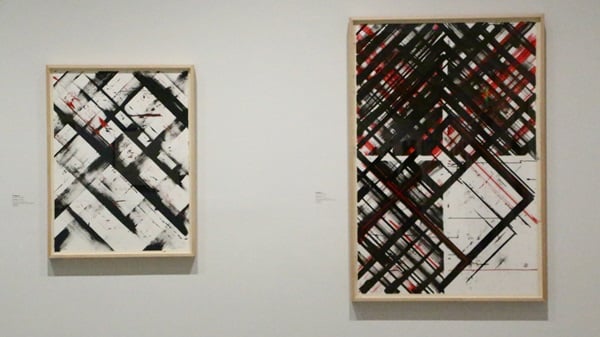Art & Exhibitions
LACMA Pays Tribute to 1960s Renegade Artist Ed Moses’s Forgotten But Brilliant Drawings
The abstract painter's early drawings were forgotten.

The abstract painter's early drawings were forgotten.

Jordan Riefe

When Ed Moses had his first show of drawings at LACMA in 1976, it was on the heels of a show at Andre Emmerich Gallery in New York that earned him the sobriquet “player” from legendary critic Clement Greenberg.
By then, Moses was middle-aged, but the LA art scene was still relatively young. While his longtime Ferus Gallery companions Larry Bell, Robert Irwin, and Craig Kauffman were pursuing Light and Space throughout the 1960s, and Finish Fetish in the 70s, Moses struck out on his own, executing graphite works like the Rose drawings from 1963, featuring densely shaded penciled areas surrounding cutouts of floral patterns.
“They reflect my obsessive-compulsive nature, where I had to do things and get the surfaces right,” Moses told artnet News on a walk-through of his new show at LACMA “Ed Moses: Drawings from the 1960s and 70s.” “I did the lines over and over and over again.” (See Leonardo DiCaprio To Donate John Gerrard’s Massive Installation To LACMA.)
The first display of his drawings in 40 years, the exhibition features 80 works, including five of the six Rose drawings from the early 60s, as well as his signature grid works from the 70s. Also on hand is a resin piece representing a brief excursion into Finish Fetish, which Moses quickly abandoned when resins were found to be toxic.

Installation view of “Ed Moses: Drawings From the 1960s and 70s.”
Photo: Jordan Riefe.
“It’s a combination of a handful of things that were already in the collection, plus the (40) promised gifts,” curator Leslie Jones told artnet News about the works Moses will donate to LACMA. “He’s become known as a large-scale abstract painter, but these early drawings were sort of forgotten, in a way.”
And yet they contain a quintessential element of Moses’s art: the mark. In discussing the importance of marking, Moses refers to the Cradle of Humankind—the African site of some of the oldest hominid fossils ever found, some dating as far back as 3.5 million years ago, when hand prints or scribbles on cave walls were the first confirmation of the existence of Homo sapiens. Moses relates his own work to these scribbles with the statement “I mark. Therefore I am”—a twist on the Cartesian maxim.
“I love mechanical drawing,” said Moses, who worked for a short time as a draftsman at the aerospace manufacturing corporation McDonnell Douglas before he became an artist. “I like making those lines, getting the density and the distribution of the graphite just right, which wet my whistle for the things that followed.”
A native of Long Beach, California, Moses grew up surfing in Hawaii while visiting his father, and surfing in Southern California when staying with his mother. Art was never on the radar, but medicine became an interest while he was in the navy, working as a scrub assistant. After the war, he attended medical school but was a lousy student and dropped out soon after enrolling.
He dated Marilyn Monroe before she was famous and, on a friend’s recommendation, took an art class under Pedro Miller, who was the first to recognize that he had potential as an artist. (See 10 LA Art Power Couples You Need to Know.)

Installation view of “Ed Moses: Drawings From the 1960s and 70s.”
Photo: Jordan Riefe.
After transferring to UCLA, Moses met Craig Kauffman who introduced him to Walter Hopps, legendary curator who started the Ferus Gallery with Ed Keinholz in 1957 and would go on to be the founding director of Houston’s Menil Collection.
“[Hopps] had another gallery called the Syndell (studio),” Moses recalled. “I remember going into the first how, and Ed Kienholz was in there along with Artie Richer and all these really goofy guys who did a lot of drugs. I wasn’t against drugs. I didn’t even know about them. I was naïve. Finally, somebody gave me a toke and I felt, ‘Wow.’ I was like a baby to bathwater. So it gave me a different vision, a different consciousness, like weed does.”
His assiduous graphites of the 60s led to the diagonal grid paintings he became associated with in the 70s. In fact, they aren’t paintings, but charcoal, acrylic, ink and masking tape on boards.
“I spent a lot of time with him talking about the work, to under understand his development from the floral pattern drawings to the grid-based drawing,” said Jones about her attempt to chart the erratic artist’s work through this period. (See West Coast Gallerists Bet Big on Los Angeles’s East Side.)
The answer is in Deconstruction, an installation he did at the Mizuno Gallery in 1969. Along with some of his surfer friends, he pulled off the roof of the space, letting the sunshine pour down through the rafters, carving dense black shadows on the floor. Moses jokes that James Turrell was his advisor on the project, but where Turrell became associated with Light and Space, Moses took a different lesson from Deconstruction—the grid, which became a constant in his work for decades.
“I don’t change, I mutate,” he said, leaning on his walker, a temporary accessory he started using after recent heart surgery. At 89, he still puts in a full day at his Venice studio, beginning at 6 a.m. And as always, process remains at the heart of what he does.
“Going back to my days in mechanical drawing, I got into the sensation of drawing lines. And by moving the pencil across, it left a residue of the graphite. Then I started patterning them in, filling them in until they fanned out and made a whole pattern.”
He paused and stared at the five massive Rose drawings in the first gallery.
“I was hoping they might light up and become some kind of magical situation,” he said. “They never did that for me. Now that I look at them, they look damn good, don’t they? You do a thing long enough and enough times, something may happen.”
Ed Moses: Drawings from the 1960s and 70s runs through August 2.